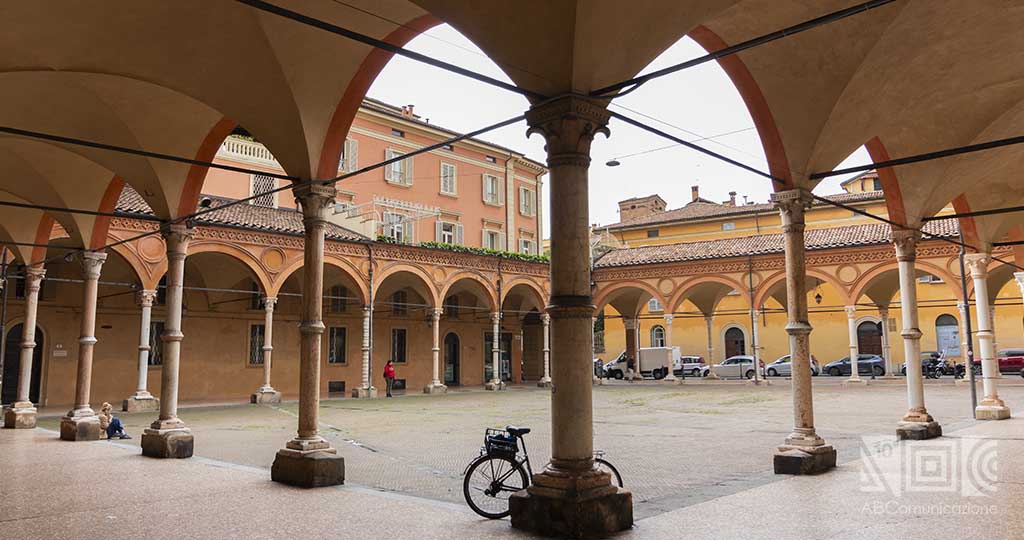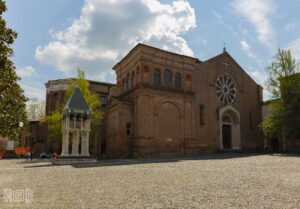Do you know that the porticoes of Bologna are nominated to become a UNESCO World Heritage Site? Find out their history and their characteristics!
The history of the porticoes
In the Middle Ages, the increase of the population due to the affirmation of the University of Bologna (check the article Bologna: the oldest University of the Western world) created the necessity of larger urban spaces.
The idea was to expand the upper floors of the buildings, creating wooden balconies that will later be supported by beams rested on the road. This is how the porticoes of Bologna borned.
Lots of balconies were built, so the Municipality of Bologna, in the XI century, introduced the obligation to build a portico for each building: so the owner had to add them. The ones who didn’t build the porticoes had to pay an extra tax.

The new porticoes were made of masonry: this decision was due to the risk of fires. Even though some old porticoes were not renewed and they are still made of wood: you can see them at Corte Isolani.
Some rules for te construction of the porticoes
There were also some rules for the construction of the porticoes: the height had to be at least 7 foot (2,66 meters) in order to allow the passage of a man on horseback and the porticoes were of public use, even if they were built by a private citizen. Their maintenance was also up to the citizens.
The porticoes of Bologna became a meeting place, where it was possible to exchange and trade assets and to find the craftsman’s workshops.
The counters of the merchants didn’t have to completely occupy the passage as not to obstruct the way to passers-by.
Some noble families decided to follow the “roman fashion” to stand out, wanting to construct their building without the porticoes. That’s the reason why, for example, Palazzo Bentivoglio and Palazzo Fantuzzi don’t have a portico.
In the Baroque period were constructed the porticoes that connected the city to the countryside such as portico degli Allemanni, from which the homonymous Theater of the Alemanni takes its name and which led to a church at almost one kilometer from the Walls of Bologna now called the Parish Church of Santa Maria Lacrimosa degli Alemanni. If you’re interested in the story of the famous Walls of Bologna, check the article A journey through the Walls of Bologna.
Did you know that there are different styles of porticoes? Read more!

The Medieval porticoes and the Renaissance porticoes
In Bologna you can see different styles of porticoes: the Medieval ones and the Renaissance ones.
You can see the Medieval porticoes at Casa Isolani, in Strada Maggiore. They are in Romanesque-Gothic style, with oak beams and they were built around 1250, in the middle of XIII century.
As for the Renaissance period, you can also see some porticoes in the city, more precisely the side portico of the San Giacomo Maggiore cathedral in St. Zamboni, the one at Palazzo Bolognini-Isolani and at Case Beccadelli in Piazza Santo Stefano, where you can also see the Basilica of Santo Stefano.
Moreover, you can admire the floral motifs decorated porticoes at Palazzo del Podestà and the portico of the ancient “dei Bastardini” hospital in St. D’Azeglio.
The portico del Pavaglione is more recent: it has a very long loggia that goes from St. De’ Musei to St. Farini.
Walking under the arcades, in Via Indipendenza you will not notice the beautiful Cathedral of San Pietro: a place of spirituality and union for the city. Discover it with us!

The porticoes of Bologna: a new UNESCO World Heritage Site
Bologna is also called the “city of porticoes” thanks to its high amount of porticoes and to their length that reaches to 37 km.
In 2006, the porticoes of Bologna were included in the Italian list of proposed sites to become a UNESCO World Heritage Site and they were also reconfirmed in the following selection.
After numerous selections, in June 2021, the arcades of Bologna officially became part of the UNESCO World Heritage: a great achievement for the city and the pride of Bologna.

The records of the porticoes of Bologna
We can divide the porticoes of Bologna in various records: the largest portico, the narrowest one, the highest one, the longest portico and the oldest one.
The largest portico is the one located in Strada Maggiore, more precisely the portico of the Basilica di Santa Maria dei Servi, a Roman Catholic basilica of 1346.
The narrowest portico can be seen in St. Senzanome, in Saragozza district. It is only 95 cm wide.
The highest portico is the one of Palazzo dell’Arcidiocesi of Bologna, the metropolitan seat of the Catholic Church in Italy belonging to the ecclesiastical region of Emilia-Romagna. It is located in St. Altabella and it is almost 10 meters high.
The longest one is the portico of San Luca, it is 3.796 meters long. If you want to know the curiosities of the portico of San Luca, do not miss the article The Sanctuary of the Madonna of San Luca between sacred and legend.
Lastly, the oldest portico of Bologna is the portico degli Alemanni. It is located outside the Walls of Bologna and it was built between 1619 and 1631. The portico degli Alemanni connects the church of Santa Maria Lacrimosa degli Alemanni to Porta Maggiore.

The portico dei servi: a special portico
The portico dei servi, surrounding the famous Basilica di Santa Maria dei Servi, hides an interesting curiosity.
The portico dei servi is not a usual portico: in the Christmas period, it hosts the beloved Fiera di Santa Lucia, where you can walk among stalls of all kinds. From sweets to Christmas ornaments, the Fiera di Santa Lucia is a must-see for those who are in Bologna during the holidays.
The tradition of the Fiera di Santa Lucia dates back to the 16th century (1501 – 1600) when, during the functions in honor of Santa Lucia, some small stalls began to settle outside the basilica. Since then, the traditional fair is repeated every year in the same period.
The Fiera di Santa Lucia is an unmissable event, what are you waiting for? Do not miss the spectacular Christmas market in Bologna!
The porticoes of Bologna are a feature that makes this city one of a kind.
Do you know the difference between the Basilica, the Duomo and the Cathedral? Don’t worry, we’ll explain it in the article on the Basilica of San Petronio.

We have seen how the arcades of Bologna are a feature that makes this city unique. In addition to the practical function of enlarging the upper floors of the houses, their artistic relevance has been such as to nominate them and make them recognized as part of the UNESCO World Heritage.
If you want to learn even more about the history of the arcades, visit the Biblioteca Salaborsa: symbol of culture and history of Bologna. This once was also the home of Botanical Garden of the city, that today sees its headquarters in Via Irnerio 42. Discover its history!
Among the long arcades there are various taverns and trattorias, where you can refresh yourself, enjoying delicious dishes of the Bolognese tradition, such as tortellini and lasagne made every day by hand from sfogline. Come and discover The five best taverns in Bologna! If instead you are more like an aperitif, read the article: Bologna to drink or go to the Quadrilatero Market!
Bibliography:
- Costa T., Bologna dalla A alla Z, Bologna, Costa Editore, 2011
- Bocchi F., Bologna e i suoi supporti, Bologna, Grafis Edizioni, 1997
- Bernabei G., I portici di Bologna, Bologna, Santarini, 1992
- Degli Esposti C., Il santuario della Madonna di San Luca e il suo portico, Bologna, Persiani editore, 2012




